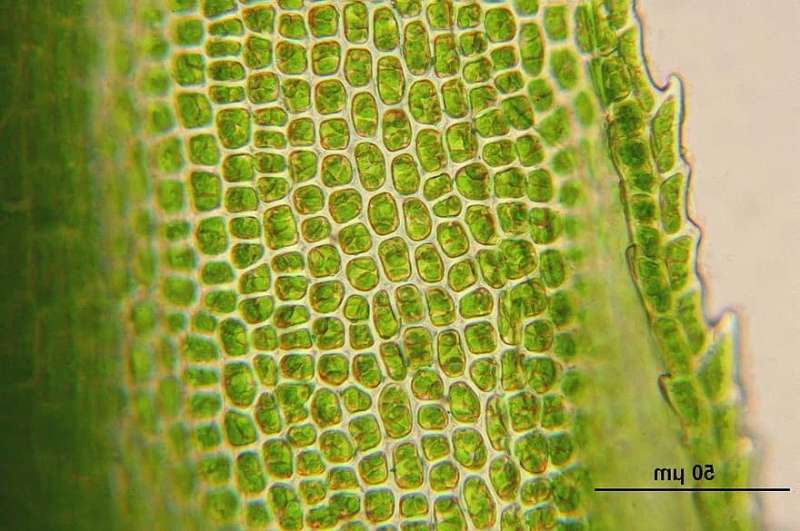Microscopic image of plant cells of the common apple-moss (Bartramia pomiformis), with cell walls that contain xylan. Credit: Leiden University
Leiden chemists have proposed a new model for enzymatic reactions in which the flexibility of the substrate is much more important than previously thought. Their results are paradigm-shifting and could have major implications for drug research and enzyme engineering. Publication in Angewandte Chemie.
The new model—called substrate-induced fit—might form a new paradigm in enzymology, the field that studies enzymes and their reactions. To understand this, consider the early days of this field. In the late 19th century, enzymes and the substances they react with—called substrates—were viewed as a lock and a key that perfectly fit onto each other. Later, proof arose that indicated that enzymes are flexible and change their shape in order to better accommodate substrates—also called the induced-fit model. Main author Fredj Ben Bdira and his colleagues now argue that the flexibility of substrates has long been overlooked and is essential for certain enzymes, hence their new model.
A suspicious enzyme
Whilst studying the enzyme xylanase, it occurred to Ben Bdira that this enzyme does not really change its conformation, even when it is exposed to different substrates. This observation does not match the aforementioned induced fit model, which states that the enzyme changes its conformation to better accommodate the substrate. Ben Bdira: "We noticed this in the crystalline state, which is usually more rigid. So we wanted to know: does this also happen in solution, when enzymes are more flexible? To study this, we developed a new probe—a small molecule that we can attach to the surface of the enzyme." This enabled the researchers to monitor changes in the enzyme in solution, at every stage of the catalytic reaction. "We were very surprised to see that the enzyme almost did not change its conformation, similar to what happens in the crystalline state."
Proof
Another thing the researchers observed was an enhancement in the so-called enzyme's millisecond time scale dynamics. Ben Bdira: "This enhancement is often attributed to the enzyme changing and optimizing its conformation. However, because we already showed that xylanase remained rigid during the different stages of the catalytic cycle, it had to be due to the binding of the substrate in different registers and orientations within the enzyme's binding cleft. This step is followed by a slow distortion of the substrate to allow the reaction by the enzyme. And that is totally new in this field."
Improving drug development
The study accentuates the importance of studying not only enzyme but also substrate dynamics to obtain a complete picture of enzyme-catalyzed reactions. Although further research is needed, the results could have major consequences for drug design. "At this moment, drug discoverers do not really take the importance of substrate flexibility into account," Ben Bdira says. "Our discovery could pave the way for the development of more potent drugs." The field of protein engineering may as well benefit from this new insight by considering substrates' flexibility to create more proficient catalysts.
Xylanase
In this study, Ben Bdira looked at xylanase, a type of beta-glycosidase that breaks down xylan. "Xylan is a chain of sugar molecules that can be found in plant cell walls. It is the main component of wood and the second most abundant renewable biomass material. The enzyme is used in the food industry and in the bleaching of paper pulp." Earlier, during his Ph.D. research, the chemist also studied xylanase, as well as other beta-glycosidases. He eventually found ways to change these enzymes for specific biotechnological applications and to improve the treatment of patients with metabolic diseases such as Gaucher's disease.
More information: Marcellus Ubbink et al. Dynamics of ligand binding to a rigid glycosidase, Angewandte Chemie International Edition (2020). DOI: 10.1002/anie.202003236
Journal information: Angewandte Chemie , Angewandte Chemie International Edition
Provided by Leiden University























